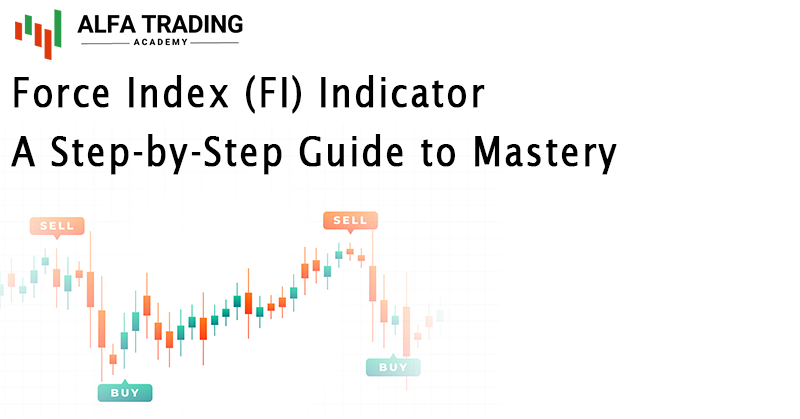Introduction to the Force Index (FI) indicator:
The Force Index (FI) is a technical indicator developed by Alexander Elder, a renowned trader, psychiatrist, and author. It was introduced to the trading community in his 1993 book “Trading for a Living.”[1] This indicator consists of a single line that fluctuates around 0 and is utilized to visualize the strength of buying or selling pressure. High positive values indicate a strong uptrend, while low negative values indicate a strong downtrend.
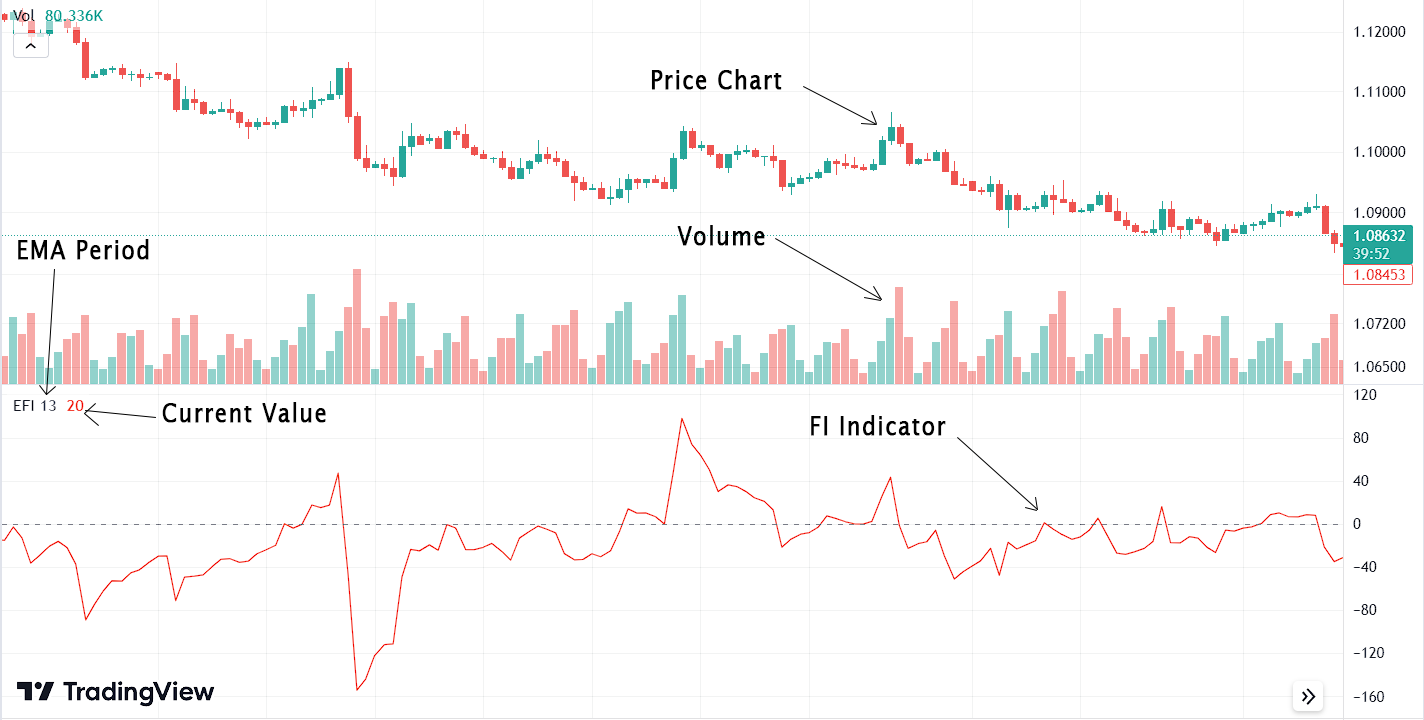
Calculation of the Force Index (FI)- The Formula:
The formula is as follows:
Force Index (FI) = 13-period EMA of [(Close Price – Previous Close Price) * Volume]
The calculation begins by analyzing price data. A higher closing price compared to previous signifies a positive outcome for the security. Conversely, if today’s closing price is lower than yesterday’s, the force is generally considered negative. This price-related information is then combined with volume data, where a greater volume accompanying the price change indicates a stronger positive or negative force.[2]
Example Calculation –
| Day/Preiod | Closing Price | Volume |
|---|---|---|
| 1 | $50 | 150,000 |
| 2 | $55 | 200,000 |
| 3 | $58 | 180,000 |
| 4 | $54 | 160,000 |
| 5 | $60 | 220,000 |
| 6 | $58 | 190,000 |
| 7 | $62 | 210,000 |
| 8 | $61 | 170,000 |
| 9 | $65 | 230,000 |
| 10 | $68 | 250,000 |
| 11 | $70 | 240,000 |
| 12 | $72 | 260,000 |
| 13 | $75 | 280,000 |
- Calculate the Price Change and Raw Force for each day:
- Day 2: Price Change = $55 – $50 = $5, Raw Force = $5 * 200,000 = $1,000,000
- Day 3: Price Change = $58 – $55 = $3, Raw Force = $3 * 180,000 = $540,000
- …
- Day 13: Price Change = $75 – $72 = $3, Raw Force = $3 * 280,000 = $840,000
- Calculate the 13-period EMA for Raw Force:
- Assuming the initial EMA value is $800,000
- For Day 2: EMA = $800,000 * (12 / 14) + $1,000,000 * (2 / 14) = $857,143
- For Day 3: EMA = $857,143 * (12 / 14) + $540,000 * (2 / 14) = $768,163
- …
- For Day 13: EMA = $X * (12 / 14) + $840,000 * (2 / 14)
After completing these calculations for all 13 days, you would have the Force Index (FI) values corresponding to each day. The EMA smooths out the FI values over time, offering a clearer picture of trend changes.
Interpreting the Value of Force Index (FI):
If the price consistently records higher closing values than the previous close value, accompanied by higher volume, it will be indicated by a higher FI value. Conversely, if the price consistently records lower closing values than the previous close value, accompanied by higher volume, it will be indicated by a lower FI value.
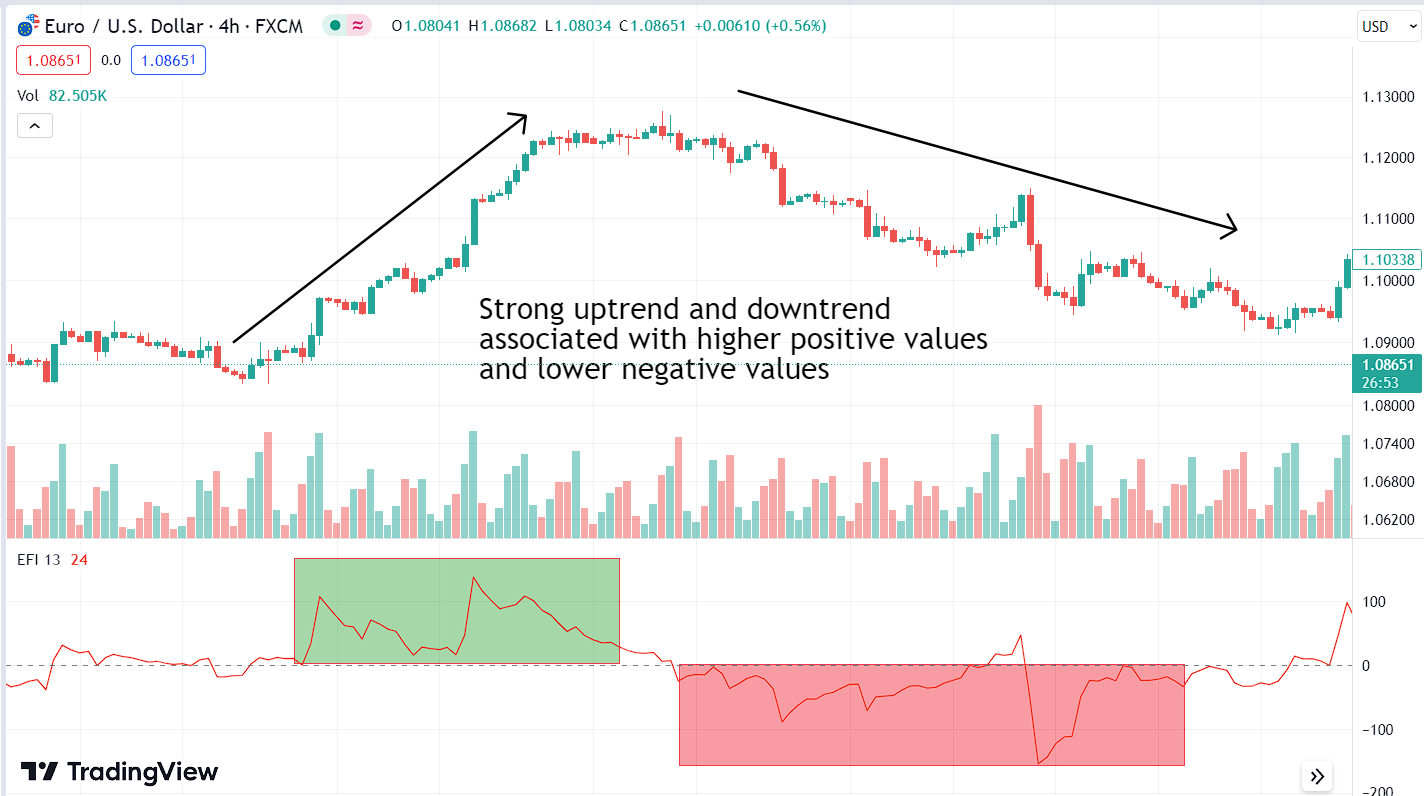
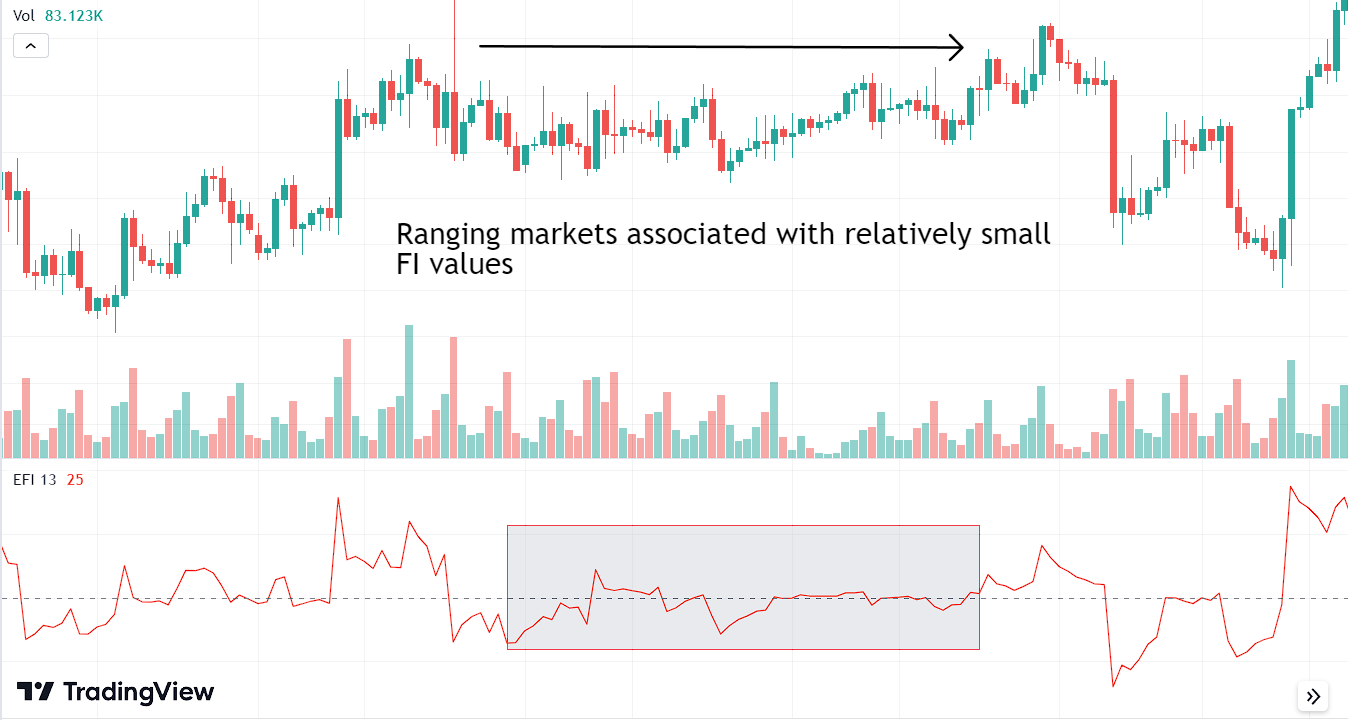
Trading strategies with the Force Index (FI):
Spotting Divergence: Divergence in trading is a signal that occurs when the price of an asset doesn’t match the movement of an indicator. It can suggest a potential trend reversal or change in market direction. There are four types of divergence.
- Regular Bullish Divergence: This occurs when the price chart of the asset forms lower lows while the oscillator forms higher lows. This indicates that despite the downward momentum of the price, the selling strength is weakening, signaling a potential bullish reversal.
- Regular Bearish Divergence: This takes place when the price chart of the asset forms higher highs while the oscillator forms lower highs. It indicates that despite the upward momentum of the price, the buying strength is weakening, signaling a potential bearish reversal.
- Hidden Bullish Divergence: Bullish hidden divergence occurs when the price chart of an asset forms a higher low, while the oscillator forms a lower low. This indicates that even though the price is showing a temporary pullback or correction in an ongoing uptrend,the uptrend is likely to continue after the pullback.
- Hidden Bearish Divergence: Bearish hidden divergence occurs when the price chart of an asset forms a lower high, but the oscillator forms a higher high. This indicates that despite the price showing a temporary bounce or correction in an ongoing downtrend, the downtrend is likely to continue after the bounce.


Using the Force Index (FI) Indicator with TradingView:
Goto Indicators, then search for “Elder Force Index” Click on the name of indicator to insert it into chart
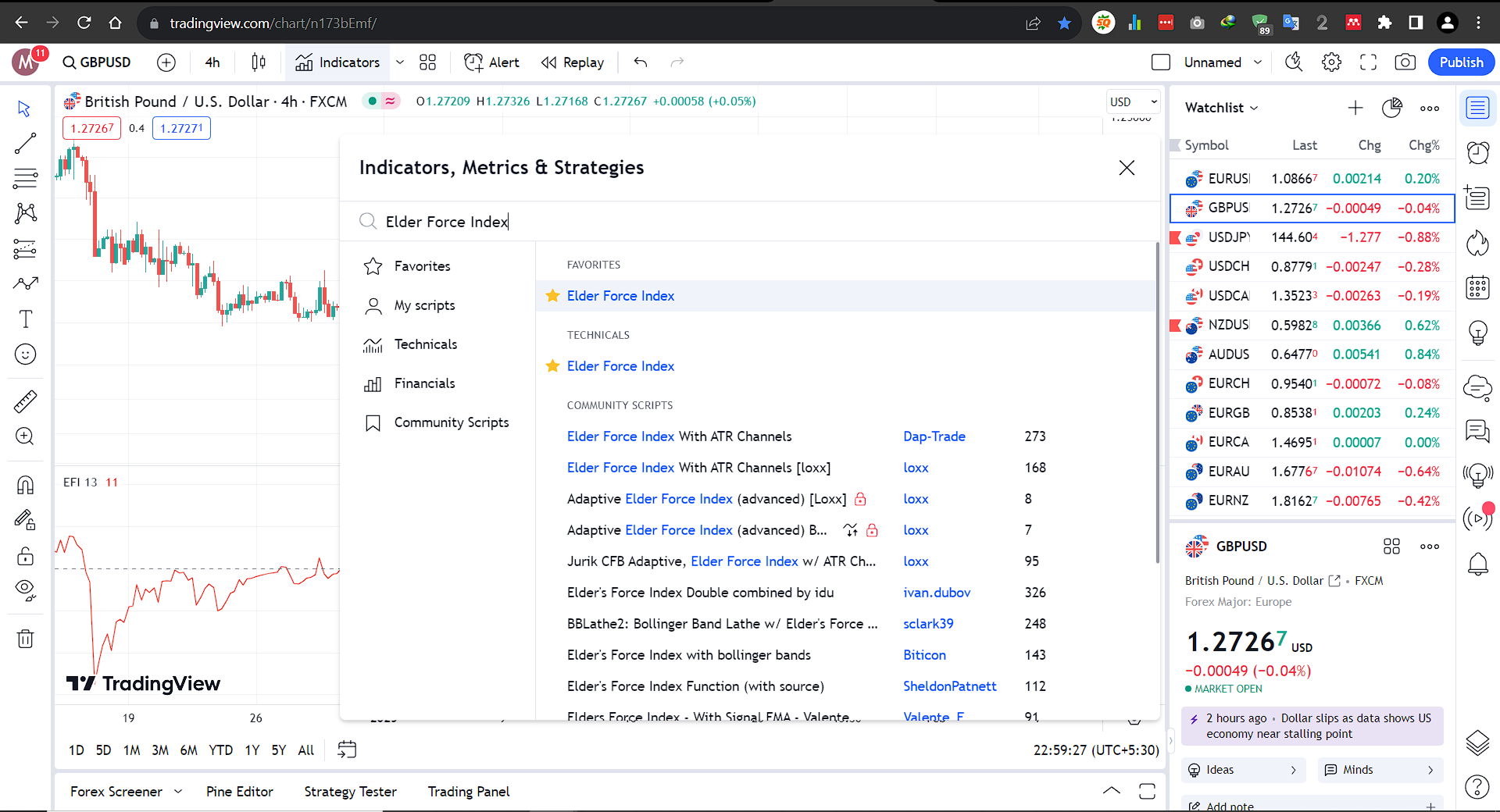
Limitations of the Force Index (FI):
The Force Index, a lagging indicator, utilizes past price and volume data to calculate an Exponential Moving Average (EMA). This averaging can lead to slower response times for trade signals. For instance, the Force Index might take a few periods to reflect a rally after an upside breakout, potentially missing optimal entry points. Short-term Force Index values (e.g., 10, 13, or 20 periods) generate frequent but potentially misleading signals due to their sensitivity to minor price or volume changes. Conversely, longer-term Force Index values (e.g., 50, 100, or 150 periods) offer more stable readings, yet they react slower to price shifts, leading to delayed trade signals.
References:
[1] A. Elder, Trading for a Living: Psychology, Trading Tactics, Money Management. Wiley, 1993. Accessed: Aug. 23, 2023. [Online]. Available: https://archive.org/details/tradingforliving00elde_0
[2] A. C. Logue, Day Trading For Dummies. Wiley, 2011. Accessed: Aug. 23, 2023. [Online]. Available: https://books.google.com/books?id=tpOdM9LsAtcC&pg=PT196
Explore our Algorithmic Trading Courses:

Cryptocurrency Investing with Python | Earn Passive Income !
Code your own Bot with Python to Automate Crypto Investing in Binance. Upload Him to a Server and He Will Do the Rest !
4.9 Rating
2.5 Hours
1.5K+
$119.99
$13.99

Binance Futures Trading with Python | Build a Market Maker Bot
Unlock the power of automated trading with Binance Futures and Python. Maximize profits with tech & expertise in trading
4.9 Rating
2.5 Hours
1.2K+
$119.99
$13.99

Forex Algorithmic Trading with Python : Build a Grid Bot
Create your own profitable Grid Bot with Python. He can trade many currency pairs at once. With free Bot included !!
4.9 Rating
3 Hours
1.5K+
$119.99
$13.99

Master Forex News Trading with Python | The Secret Strategy
Build an Automated Trading Bot to Capture the Volatility of News Events-with Semi Intelligent Take Profit and Stop Loss
4.9 Rating
2.5 Hours
1.2K+
$119.99
$13.99

Binance Futures Trading with Python | Build a Martingale Bot
Stop wasting time on Paid trading Bots – Create your own Binance Futures Bot and take control of your trading strategy !
4.9 Rating
2.5 Hours
1.5K+
$119.99
$13.99

The Complete Foundation Binance Algorithmic Trading Course
Binance Algorithmic Trading from A-Z | Spot and Futures trading, Build Strategies, Automate with Cloud Server + More
4.9 Rating
4 Hours
1.5K+
$119.99
$13.99

Forex Algorithmic Trading with Python : Build a DCA Bot
Create your own profitable DCA Bot with Python. He can trade many currency pairs at once. With free Bot included !!
4.9 Rating
3 Hours
1.5K+
$119.99
$13.99

The Ultimate Forex Algorithmic Trading Course | Build 5 Bots
Build your own SMA Crossover Bot, Bollinger Bands Trading Bot , Grid Bot, DCA Bot and a Basic Bot to learn Fundamentals
4.9 Rating
4 Hours
1.5K+
